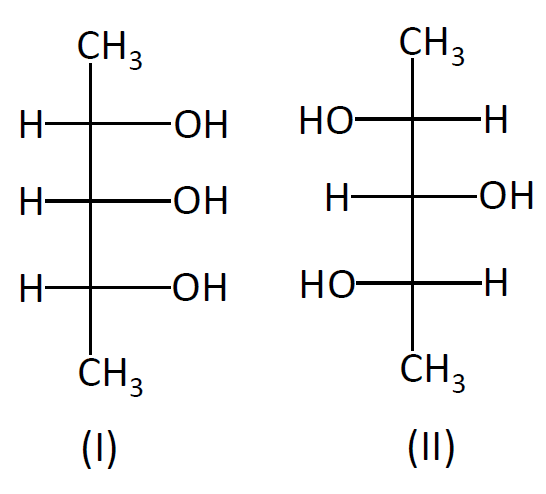
Find out the relation between I and II

A. Enantiomers
B. Diastereomers
C. Homomers
D. Structural isomers

Answer
583.5k+ views
Hint: Stereoisomers are compounds of the same molecular formula but the arrangement of the groups to carbon atoms relative to each other are different. If we place a mirror in between above compounds we see that they are not mirror images and thus they are diastereomers.
Complete step by step solution:
We have been given two organic compounds with the same molecular groups but different arrangements with respect to each other. Such compounds are known as stereoisomers. In stereoisomers, we have two forms: enantiomers and diastereomers. Enantiomers are optical isomers and they are related to each other when they are mirror images of each other. Please note that representation of compounds is shown in two dimensions but carbon atoms form covalent bonds in tetrahedral. So spatial arrangements of the atom do matter when reactivity is considered and thus above mentioned classification came under study. When the above mentioned reflection criteria does not relate the compounds then they are called as diastereomers. So above given compounds are diastereomers. We can say that option B is correct. In structural isomerism, the groups are bonded to different carbon atoms in order. This is not true for the above given compounds. Homomer is not related to the polymers but different representations and above examples are polymers with hydroxyl groups in different planes.
Note: It is better in such a problem to be thorough with the different definitions. Test the given compounds with each definition and then reduce to the correct option. Many times two options, like here A and B are two types of stereoisomers. If one is ticked, the other is straightway crossed out. Therefore, thorough definition will help to solve the problem.
Complete step by step solution:
We have been given two organic compounds with the same molecular groups but different arrangements with respect to each other. Such compounds are known as stereoisomers. In stereoisomers, we have two forms: enantiomers and diastereomers. Enantiomers are optical isomers and they are related to each other when they are mirror images of each other. Please note that representation of compounds is shown in two dimensions but carbon atoms form covalent bonds in tetrahedral. So spatial arrangements of the atom do matter when reactivity is considered and thus above mentioned classification came under study. When the above mentioned reflection criteria does not relate the compounds then they are called as diastereomers. So above given compounds are diastereomers. We can say that option B is correct. In structural isomerism, the groups are bonded to different carbon atoms in order. This is not true for the above given compounds. Homomer is not related to the polymers but different representations and above examples are polymers with hydroxyl groups in different planes.
Note: It is better in such a problem to be thorough with the different definitions. Test the given compounds with each definition and then reduce to the correct option. Many times two options, like here A and B are two types of stereoisomers. If one is ticked, the other is straightway crossed out. Therefore, thorough definition will help to solve the problem.
Recently Updated Pages
A man running at a speed 5 ms is viewed in the side class 12 physics CBSE

State and explain Hardy Weinbergs Principle class 12 biology CBSE

Which of the following statements is wrong a Amnion class 12 biology CBSE

Two Planoconcave lenses 1 and 2 of glass of refractive class 12 physics CBSE

The compound 2 methyl 2 butene on reaction with NaIO4 class 12 chemistry CBSE

Bacterial cell wall is made up of A Cellulose B Hemicellulose class 12 biology CBSE

Trending doubts
What are the major means of transport Explain each class 12 social science CBSE

Which are the Top 10 Largest Countries of the World?

Draw a labelled sketch of the human eye class 12 physics CBSE

Explain sex determination in humans with line diag class 12 biology CBSE

The pH of the pancreatic juice is A 64 B 86 C 120 D class 12 biology CBSE

Give 10 examples of unisexual and bisexual flowers




